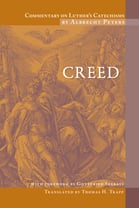The following explanation of the Communion of Saints is adapted from Commentary on Luther’s Catechisms: Creed.
The Communio Sanctorum as a “Holy Community”
In keeping with some paraphrases of the Symbols from the twelfth century, [Martin] Luther wanted to render “association of saints” (Gemeinschaft der Heiligen), which did not sound right in German, as “congregation of saints” (Gemeinde der Heiligen), as “communion or assembly (Gemeine or Sammlung) ... of those who live in true faith, hope, and love.” But this would forfeit the biblical sense of the word “Koinonia.” For this reason, κοινωνία, in the specific meaning of the word, cannot be used as another way to say ἐκκλησία, and is thus to be interpreted, with respect to its context, as needless repetition. Luther’s translation “a holy community” (ein heilige Gemeine) conceals the original meaning. For this reason, the modern ecumenical rendering returns to “communion of saints” (Gemeinschaft der Heiligen); one can justify this translation on the basis of the fact that “community” can be understood too much in the sense of a physical assembly.
The biblical sense of the word “communion,” with specific permission granted to participate in core
activities, as is guaranteed to an individual, or else the right to participate that is obtained by someone
else, is not a foreign notion to Luther. ... When he was commenting on 1 Cor. 10:16f., being particularly
exercised, as he was, in his battle with the “Enthusiasts,” he made it clear that the genitive at this point
identifies the benefit that we get to share, which by extension binds us together, one to the other.
Particularly in his early sermons on death and on the Lord’s Supper,
Luther emphasized both the
“
admirabile commercium
,” the “happy exchange and encounter”
between Christ and the believer, as gift
and responsibility, grace and calling. Christ and His saints come before God on our behalf and He
protects us in all temptations, so that we can act in mercy for those on earth who are “needy” in body or
soul. The priesthood of all believers is properly located spiritually at this point. ... It is lived out as one gives
of self to the neighbor in both internal and external ways, in proclamation of the Word, petition, and
caring actions. A person in the late Middle Ages especially sought the intercessions of the saints on behalf
of his own earthly needs and looked for the way that their accomplishments could be transferred over to
his account through indulgences. The reformer showed how it was Christ who sacrificed Himself on our
behalf and freed us from concern for ourselves, so that we can act freely toward others in love.
Oneness of the Church Is Rooted in Christ’s Oneness with the Heavenly Father
These insights are sadly not treated fully in the catechisms. The fact that Luther did not abandon such
thinking altogether after the battle for the real presence
, but can still articulate such issues after
1524, can be demonstrated in his commentary on the High Priestly Prayer that was formulated at the same
time as he was preaching his catechetical sermons.
In this context, he depicts the spiritual comfort that
comes for each individual from the calming assurance that each one is “brought by the Spirit of God into
the body,” into the
Communio sanctorum
; Luther is supported by the evangelists in maintaining that the
oneness of the Church is rooted in Christ’s oneness with the heavenly Father. Whoever dares to lay hands
on any individual believer gets entangled in the unbreakable unity that each one shares with Peter, Paul,
Mary and Isaiah, with Christ Himself, with all angels and creatures, finally in reality with God the Father
Himself,
since each Christian is part of the body of the Church, and the Church reposes in Christ and
Christ Himself reposes in the Father.
That which is applicable for the individual believer is even more true for Christendom as a whole; it is
completely enveloped and hidden within the almighty saving presence of the triune God. It is not the
Spirit alone who “remains” with His community until the Last Day.
He constantly draws all members
together under the one Christ, who is the head,
and holds the community close by its Lord.
The Church is
thus framed by the presence of Christ; the merciful God-Father is Himself close at hand in Christ at the
same time. Along with Tertullian and Augustine,
Luther praises the Church as the place where the triune
God prepares the eschatological dwelling place, where, though hidden, He is enthroned already and reigns
in faith and in love.
Blog post adapted from Commentary on Luther’s Catechism: Creed © 2011 Concordia Publishing House.
 Albrecht Peters’s commentary places the catechisms in the larger context of Luther’s writings and within the history of Christian teaching and theology.
Albrecht Peters’s commentary places the catechisms in the larger context of Luther’s writings and within the history of Christian teaching and theology.


Read more...
 Albrecht Peters’s commentary places the catechisms in the larger context of Luther’s writings and within the history of Christian teaching and theology.
Albrecht Peters’s commentary places the catechisms in the larger context of Luther’s writings and within the history of Christian teaching and theology.























